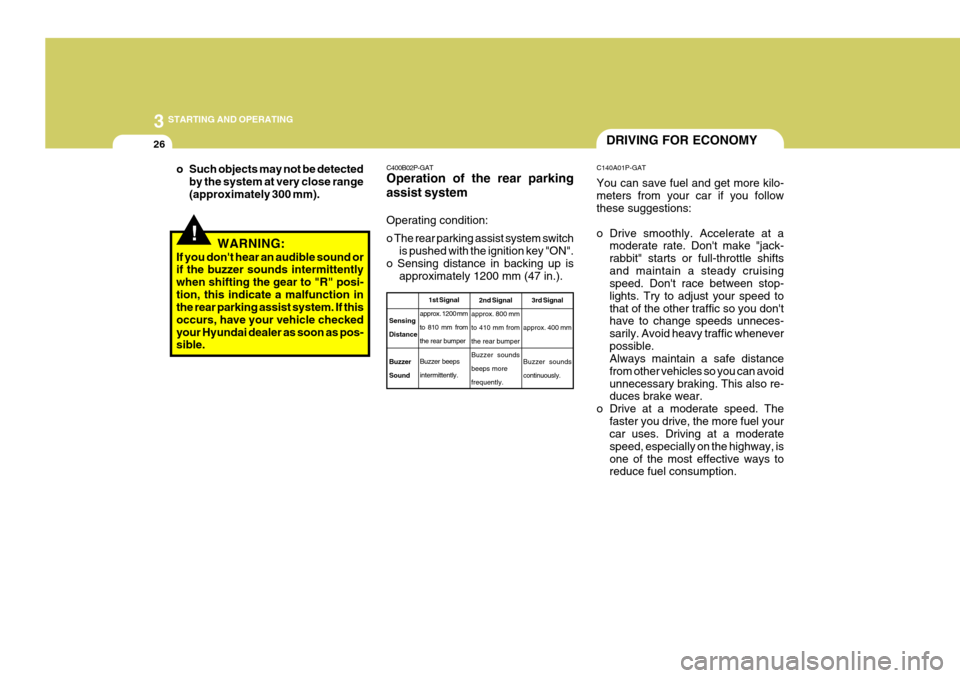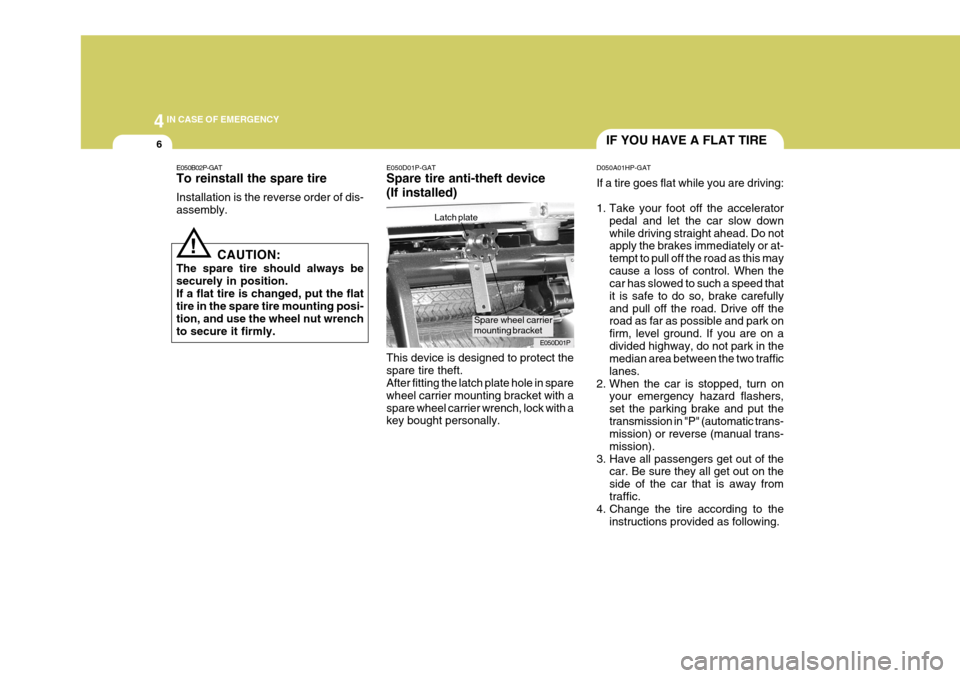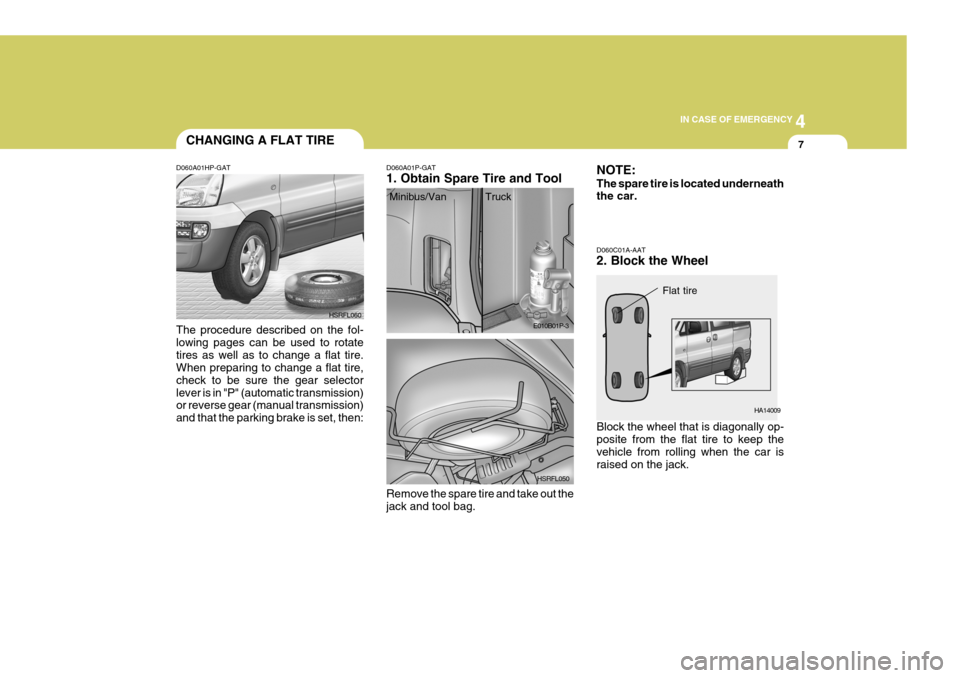2007 Hyundai H-1 (Grand Starex) brake
[x] Cancel search: brakePage 168 of 284

3 STARTING AND OPERATING
26
!
o Such objects may not be detected
by the system at very close range (approximately 300 mm).
WARNING:
If you don't hear an audible sound or if the buzzer sounds intermittently when shifting the gear to "R" posi-tion, this indicate a malfunction in the rear parking assist system. If this occurs, have your vehicle checkedyour Hyundai dealer as soon as pos- sible. C400B02P-GAT Operation of the rear parking assist system Operating condition: o The rear parking assist system switch
is pushed with the ignition key "ON".
o Sensing distance in backing up is approximately 1200 mm (47 in.).
1st Signal
approx. 1200 mm
to 810 mm fromthe rear bumper Buzzer beeps intermittently.
SensingDistance Buzzer Sound 2nd Signal
approx. 800 mmto 410 mm fromthe rear bumperBuzzer soundsbeeps morefrequently. 3rd Signal
approx. 400 mm Buzzer sounds continuously.
DRIVING FOR ECONOMY
C140A01P-GAT You can save fuel and get more kilo- meters from your car if you follow these suggestions:
o Drive smoothly. Accelerate at a moderate rate. Don't make "jack- rabbit" starts or full-throttle shiftsand maintain a steady cruising speed. Don't race between stop- lights. Try to adjust your speed tothat of the other traffic so you don't have to change speeds unneces- sarily. Avoid heavy traffic wheneverpossible. Always maintain a safe distance from other vehicles so you can avoidunnecessary braking. This also re- duces brake wear.
o Drive at a moderate speed. The faster you drive, the more fuel yourcar uses. Driving at a moderate speed, especially on the highway, isone of the most effective ways to reduce fuel consumption.
Page 169 of 284

3
STARTING AND OPERATING
27
o Keep your car in good condition. For better fuel economy and reduced maintenance costs, maintain your car in accordance with the mainte- nance schedule in Section 6. If youdrive your car in severe conditions, more frequent maintenance is re- quired (see Section 6 for details).
o Keep your car clean. For maximum service, your Hyundai should bekept clean and free of corrosivematerials. It is especially important that mud, dirt, ice, etc. not be al- lowed to accumulate on the under-side of the car. This extra weight can result in increased fuel con- sumption and also contribute to cor-rosion.
o Travel lightly. Don't carry unneces-
sary weight in your car. Weight re-duces fuel economy.
o Don't let the engine idle longer than
necessary. If you are waiting (andnot in traffic), turn off your engine and restart only when you're ready to go. o Remember, your Hyundai does not
require extended warm-up. As soonas the engine is running smoothly, you can drive away. In very cold weather, however, give your enginea slightly longer warm-up period.
o Don't "lug" or "over-rev" the engine.
Lugging is driving too slowly in toohigh a gear resulting in the engine bucking. If this happens, shift to a lower gear. Over-revving is racingthe engine beyond its safe limit. This can be avoided by shifting at the recommended speeds.
o Use your air conditioning sparingly. The air conditioning system is oper-ated by engine power so your fueleconomy is reduced when you use it.
o Don't "ride" the brake or clutch pedal.
This can increase fuel consumption and also increase wear on these components. In addition, driving with your foot resting on the brake pedalmay cause the brakes to overheat, which reduces their effectiveness and may lead to more serious con-sequences.
o Take care of your tires. Keep them
inflated to the recommended pres-sure. Incorrect inflation, either too much or too little, results in unnec- essary tire wear. Check the tire pres-sures at least once a month.
o Be sure that the wheels are aligned
correctly. Improper alignment canresult from hitting curbs or driving too fast over irregular surfaces. Poor alignment causes faster tire wearand may also result in other prob- lems as well as greater fuel con- sumption.
Page 173 of 284

3
STARTING AND OPERATING
31
D180J01P-GAT Weather strip To prevent freezing of the weather strip on the doors, the roof, etc., theyshould be treated with silicone grease. D180K01P-GAT Snow tires The use of snow tires is recommended for driving in snow and ice. To pre- serve driving stability, mount snow tires of the same size and tread pattern onall four wheels. Snow tires worn more than 50% are no longer suitable for use as snow tires.Snow tires which do not meet specifi- cations must not be used. NOTE: The laws and regulations concern- ing snow tires (driving speed, re- quired use, type, etc.) vary. Find out and follow the laws and regula-tions in your area. D180L01P-GAT Tire chains If tire chains are to be used, be sure that they are mounted on the rearwheels. Use only tire chains which are de- signed for use with the tires mountedon the vehicle; use of the incorrect size or type of chain could result in damage to the vehicle body.Before driving over long stretches of road which are free of snow, you should remove the chains to avoid damage tothe tires. NOTE: The laws and regulations concern- ing tire chains vary. Find out and follow the laws and regulations in your area.
D180H01P-GAT Parking brake If the atmospheric temperature is be- low freezing, park the vehicle with thegearshift lever in 1st or reverse and do not engage the parking brake. If the parking brake is engaged and there ismoisture on the brake linings, the lin- ings could become frozen to the brake drums, making it impossible to releasethe parking brake. When parking on a steep slope, turn the front wheels in towards the kerband chock the wheels.
D180I01P-GAT Washing the vehicle The salt and other chemicals spread on winter roads in some areas can have a detrimental effect on a vehicle body. You should therefore wash thevehicle as often as convenient in ac- cordance with our care-instruction. Have a preservative applied and theunderfloor protection checked at an authorized HYUNDAI dealer before and after the cold weather season.
Page 182 of 284

44IN CASE OF EMERGENCY
6IF YOU HAVE A FLAT TIRE
E050D01P-GAT Spare tire anti-theft device (If installed) This device is designed to protect the spare tire theft. After fitting the latch plate hole in spare wheel carrier mounting bracket with aspare wheel carrier wrench, lock with a key bought personally. Latch plate
E050D01PD050A01HP-GAT If a tire goes flat while you are driving:
1. Take your foot off the accelerator
pedal and let the car slow down while driving straight ahead. Do not apply the brakes immediately or at- tempt to pull off the road as this maycause a loss of control. When the car has slowed to such a speed that it is safe to do so, brake carefullyand pull off the road. Drive off the road as far as possible and park on firm, level ground. If you are on adivided highway, do not park in the median area between the two traffic lanes.
2. When the car is stopped, turn on your emergency hazard flashers,set the parking brake and put thetransmission in "P" (automatic trans- mission) or reverse (manual trans- mission).
3. Have all passengers get out of the car. Be sure they all get out on theside of the car that is away fromtraffic.
4. Change the tire according to the
instructions provided as following.
Spare wheel carrier mounting bracket
E050B02P-GAT To reinstall the spare tire Installation is the reverse order of dis- assembly.
CAUTION:
The spare tire should always besecurely in position.If a flat tire is changed, put the flat tire in the spare tire mounting posi- tion, and use the wheel nut wrenchto secure it firmly.
!
Page 183 of 284

4
CORROSION PREVENTION AND APPEARANCE CARE
7
4
IN CASE OF EMERGENCY
7CHANGING A FLAT TIRE
D060A01HP-GAT The procedure described on the fol- lowing pages can be used to rotatetires as well as to change a flat tire. When preparing to change a flat tire, check to be sure the gear selectorlever is in "P" (automatic transmission) or reverse gear (manual transmission) and that the parking brake is set, then: HSRFL060D060A01P-GAT 1. Obtain Spare Tire and Tool
E010B01P-3
HSRFL050
Remove the spare tire and take out the jack and tool bag. D060C01A-AAT 2. Block the Wheel Block the wheel that is diagonally op- posite from the flat tire to keep the vehicle from rolling when the car israised on the jack.
HA14009
NOTE: The spare tire is located underneath the car.
Flat tire
Minibus/Van Truck
Page 184 of 284

44IN CASE OF EMERGENCY
8
D060D01A-AAT 3. Loosen Wheel Nuts The wheel nuts should be loosened slightly before raising the car. To loosenthe nuts, turn the wrench handle coun- terclockwise. When doing this, be sure that the socket is seated completelyover the nut so it cannot slip off. For maximum leverage, position the wrench so the handle is to the right asshown in the illustration. Then, while holding the wrench near the end of the handle, pull up on it with steady pres-sure. Do not remove the nuts at this time. Just loosen them about one-half turn. HSRFL056
D060E01P-AAT 4. Put the Jack in Place
Rear
E040A03P
HSRFL040
HSRFL042
2WD Front
4WD Front
The method for jacking up the vehicle should be remembered in order tochange a tire in the event of a puncture and in order to install tire chains. After stopping the engine and applying the parking brake on a flat level sur-face, also use chocks to hold the wheels. Position the jack only at the specified points indicated in the illustration, and the use of the jack at other points coulddamage the vehicle body.
Page 190 of 284

44IN CASE OF EMERGENCY
14
!
!
1) If any of the loaded wheels or sus-
pension components are damaged or the vehicle is being towed with the rear wheels on the ground, use a towing dolly under the rear wheels.
o Manual Transmission: If you do not use a towing dolly,place the ignition key in the "ACC"position and put the transaxle in "N (Neutral)".
HHA4002
CAUTION:
Do not tow with the key removed or in the "LOCK" position when tow- ing from the front without a towing dolly. A vehicle with an automatic trans-mission should never be towed from the front with the rear wheels on the ground. This can cause seriousdamage to the transmission.
2) If the vehicle is being towed with the
front wheels on the ground, be sure the parking brake is released.
o Automatic Transmission:
Be sure to use a towing dolly under the rear wheels. CAUTION:
NOTE: Before towing, check the level of the automatic transmission fluid. If it is below the "HOT" range on thedipstick, add fluid. If you cannot add fluid, a towing dolly must be used.
3) It is recommended that your vehicle
be towed with all the wheels off the ground.
Page 192 of 284

44IN CASE OF EMERGENCY
16
Tow at the illustrated point. Using any part other than the designated towing hooks could result in damage to ve- hicle body. The regulations concern-ing towing may differ from country to country. It is recommended that you may obeythe regulations in your area. If your vehicle is to be towed, pay careful attention to the following points.
1. Move the gearshift lever to neutral.
2. Be sure the towing speed is within
the legal limit. 3. On vehicles with steering lock sys-
tem, turn the ignition switch to "ACC"to unlock the steering wheel. If you will be using the turn signals while being towed, turn the ignition switchto "ON" position.
4. To prevent the exhaust gas from
entering the towing vehicle, set theair selection lever on the heater control to the recirculation position.
5. Turn on the hazard warning lamps.
6. During towing, make sure that close contact is maintained between thedrivers of both vehicles, and thatthe vehicles travel at low speed. Avoid abrupt starting or stopping which might subject the vehicles toshock.
7. If the transmission is malfunction-
ing or damaged, tow the vehiclewith the rear wheels raised off the ground.
8. If the vehicle is equipped with a brake booster system, the brakeboosting power will be lost and greater force will be required todepress the brake pedal.
JFS920-1
Rear (Minbus/Van)
Towing hook
9. If the vehicle is equipped with apower steering system, greater force will be required to operate the steering wheel.
NOTE:
o Your vehicle should only be used to tow another vehicle if the weight of the other vehicle is less than that of your vehicle.
o Before towing, check the level of the automatic transaxle fluid. If itis below the "HOT" range on thedipstick, add fluid. If you cannot add fluid, a towing dolly must be used.